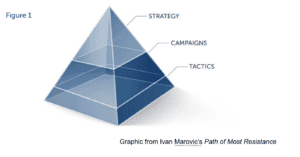Editors’ Note: This is part 1 of a 4-part series on the basics of strategy for nonviolent direct action.
 So much of our activism is failing for lack of strategy. When it comes to taking to the streets, our protests are often reactive and short-sighted. That approach to activism isn’t consistent with history’s most successful freedom movements. Our freedom-seeking predecessors learned over time that good strategy makes activism more powerful and effective.
So much of our activism is failing for lack of strategy. When it comes to taking to the streets, our protests are often reactive and short-sighted. That approach to activism isn’t consistent with history’s most successful freedom movements. Our freedom-seeking predecessors learned over time that good strategy makes activism more powerful and effective.
Srdja Popovich, who founded the pro-democracy movement that ousted the brutal Serbian dictator Slobodan Milosevic, once told our Harvard class:
“There are two types of revolutions: spontaneous and successful.”
Freedom seekers don’t overcome oppression by passion alone or because our cause is so righteous. We win by waging struggle against oppressive systems with skill. And a vital skill for waging struggle is the ability to strategize.
Jesus invokes a principle that captures the essence of strategic thinking for direct action he says “If one of you wanted to build a tower, wouldn’t you first sit down and calculate the cost, to determine whether you have enough money to complete it?” (Luke 14:28)
Jesus wasn’t talking about grassroots activism in that passage, but the principle – that we should count the cost before taking on great endeavors – is salient.
Keep reading to discover the levels of the strategy pyramid and how they can help you better prepare for the audacious task of justice-seeking through nonviolent collective action.
The 3 Levels of Strategy and How to Use Them
The pyramid helps us visualize the big picture of the struggle in three tiers:
 Strategy: Consider this the blueprint of how we will conduct our struggle for change. This includes our vision for the future, the mission of our group in realizing that future, and the values that govern the way we pursue that vision. This is the view of the struggle from 30,000 feet.
Strategy: Consider this the blueprint of how we will conduct our struggle for change. This includes our vision for the future, the mission of our group in realizing that future, and the values that govern the way we pursue that vision. This is the view of the struggle from 30,000 feet.
- Campaigns: This is the mortar that connects our strategy to specific resistance actions. Campaigns are time-bound pushes to achieve specific milestones in your movement’s vision of tomorrow. Campaigns often involve many different types of actions and are chosen based on your best analysis of the conflict situation.
- Tactics: These are the bricks and other materials we use to build the actual tower. Tactics are specific actions like protests, rallies, blockades, boycotts, and others you perform to implement your strategy. By themselves, tactics are not movements. And, usually, one tactic isn’t powerful enough to move the needle of change very far. But well-chosen tactics are the bread and butter of a winning strategy.
Freedom movements are usually more successful when we start planning from the top of the pyramid rather than the bottom. This kind of strategic thinking and planning can give us the advantage we often miss when we fail to count the cost before acting.
What Strategy Can’t Do and Why It’s Still Worth Doing
Boxing legend Mike Tyson once famously said, “Everyone has a plan until you get punched in the mouth.” It’s true. A strategy is a powerful way to organize our resources and actions. However, once you act, the conflict situation changes because your opponent will respond.
Because you can’t predict your opponent’s response with complete accuracy, you have to regroup, re-evaluate, and re-strategize given the new circumstances.
Therefore, having a strategy doesn’t guarantee you’ll succeed at achieving your goal, but it does increase your chances.
You might ask, Well, if you’ll have to throw the plan away as soon as you begin to act, then why bother planning in the first place?
Consider it like a jazz pianist performing at Carnegie Hall. They know the song they intend to play. Rarely do they play it perfectly. They make mistakes. They improvise new melodies. But whatever deviations they may make within the three minutes of that piece don’t derail the performance altogether, because the artist knows the piece they’re trying to play.
Strategy is sort of like that. There will be unexpected setbacks, errors, and needs to pivot, but we’re less likely to be derailed completely when we know the song we’re trying to play.
In this series, you will take an in-depth look at each level of the strategy pyramid. To make sure you don’t miss a post, join our weekly email here.


